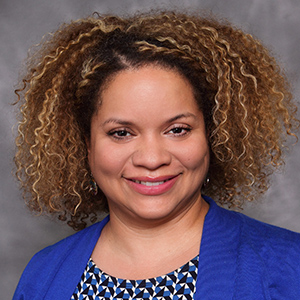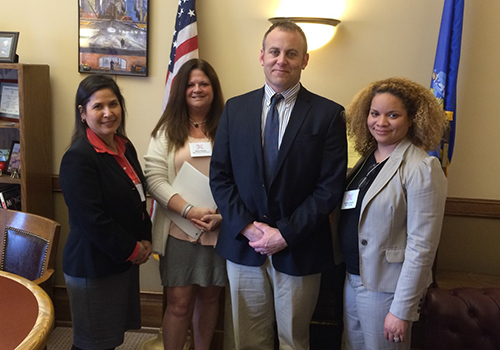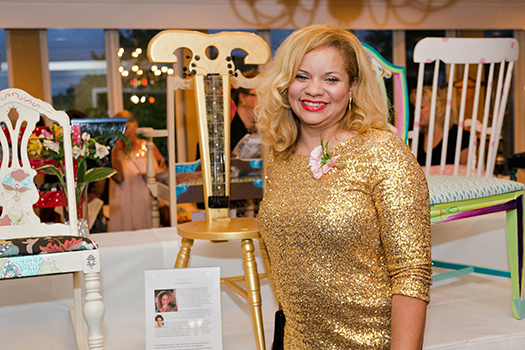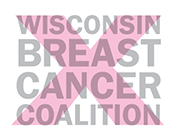 WBCC Involvement
WBCC Involvement
Rare Chair Affair Artist (2016)
Board Member (2017–22), Board President (2018–19), Vice President (2021–22)
Member, Fund Development and Education Committees
When did you first become a part of the WBCC? What were your reasons for joining the organization?
I first learned about the WBCC in 2014, shortly after my diagnosis with breast cancer, when I attended an educational meeting that was being led by Dawn Anderson on breast cancer and the environment.
In 2016 I got involved again with WBCC when I was invited to attend State Advocacy Day. The advocacy training and shared sense of purpose made me fall in love with the vision of WBCC. I loved the idea of taking action in a very tangible way for myself and others impacted by breast cancer. I lost my mother to breast cancer in 2007 and I just remember being so angry with what breast cancer awareness and information looked like at that time. I felt that there was an erasure of people like my mom, who lost her life to metastatic breast cancer. In the media and with the corporatization of the awareness movement, things were all about pink, pink, pink or buying some product where a company would give a small portion of the purchase price to charity.
When I really started volunteering for the WBCC beginning in 2016, I felt like I needed them more than they needed me. WBCC’s vision and work for advocacy was such a call to action for me.

What do you consider the most significant achievements of the WBCC?
To me the Wisconsin Breast Cancer Coalition was ahead of its time. Our motto of going beyond the pink ribbon means going beyond just awareness of breast cancer to advocacy and support of policies and education that impact people’s lives.
The advocacy work over the years, be it bringing to the attention of legislators the impact and changes that were made to the Wisconsin Well Woman Program (where there were health navigators in every county and then a move towards a model of 12 for the state) and the negative impact that had, to the work and advocacy that’s been done around women who have higher risk of breast cancer if they have dense breast tissue and the support of legislation stating that doctors need to notify women if that’s so.
Also, their work to collaborate with other breast cancer organizations around the state to increase everyone’s impact and voice is so significant and shows that the WBCC understands that we have strength in numbers and that the collective lift and impact of all the work is what matters most
What are the two or three most important contributions you have made to the WBCC?
I feel like the most significant impacts I’ve made to WBCC were answering the call when needed and asked, leading the organization through a tumultuous time when we shifted from a model of employing an executive director to employing an administrator, and hiring the PHENOMENAL Lakesha Jones.

(photo courtesy of Tammy Elias, Image Dynamix Inc.)
When I was a survivor artist, Sandra Gines (executive director at that time) needed assistance with the planning committee for the Rare Chair Affair because more than half of the people who were on the committee stepped down 2–3 months before the RCA that year. And when they stepped down, Lindsey Nathan O’Connor and I stepped up.
It was from that work that I was invited to consider joining the board and I did. In my second year on the board Sandra suggested that I think about being president. I didn’t think that I was qualified or the right person for the job. I mean I knew how to organize events and throw a good party – but board president, no way! At the time no one else wanted the job, so I stepped up again.
When Sandra had to leave the WBCC, many people did not know how close we came to disbanding. I felt that I couldn’t let that happen and a couple of key board members felt the same. Many people had left our already small board and there was a lot of fear about if we could continue without an executive director. I took Sandra’s outgoing advice that we hire a part-time administrator until we could right WBCC’s financial ship, and I brought that to the board and they agreed.
Who are two or three members of the WBCC who should be recognized as part of the organization’s history? Why are they important?
Pat Skowronski – may she rest in power. Although I did not have the privilege to know her, she poured into so many survivor artists with her talent and light.
Kathleen Harris as one of the founding members of WBCC. We would not be here without her and she continues her advocacy work and service to the organization to this day with the Policy Committee.
What has your involvement with the WBCC meant to you?
It has meant so much. It gave me hope when I was scared when first diagnosed, and it helped me turn my anger and pain at what breast cancer had taken from me into purpose and action.
(August 2024)
